
9 minute read
A New Spirit of Fraternalism
This 1957 photo includes six key Gleaner o cers and directors: (from left) Roy Rathman, Director from 1957-1973; J. Lee Strachan, Director from 1939-1969, Treasurer from 1955-1961 and 1961-1971; Joseph Kulick, Vice President 1966-1972, Treasurer from 1974-1977, Director, 1957-1977; R. George Ransford, President from 1946-1979, General Counsel from 1940-1985; Harry Hough, Director from 1930-1962, Supreme Chief Gleaner in 1922 and 1930; and Wayne Hudson, Director from 1955-1969.
Plans were completed and bids received for the new building in January 1956. The low bid of $782,397 was submitted by J.A. Friedman Inc. and a completion date of January 1957 established.
Advertisement
The new, 39,000-square-foot building was larger than Gleaner Life’s immediate needs. President Ransford proposed to rent nearly half the space and estimated rental income would exceed $66,000 per year. It proved to be an excellent decision since operating costs for the building were only $34,860 the fi rst year. The advertising fi rm of McManus, John & Adams was the fi rst tenant, paying $68,280 per year for 14,975 square feet of space.
The original bid for the Temple was evidently withdrawn and a committee composed of President Ransford, J. Lee Strachan and William Woodward was formed to dispose of the property. A land contract for $170,000 was considered and rejected. The building eventually was sold to the Newman Foundation at Wayne State University for $125,000. The deed was transferred to Cardinal Edward Mooney, Archbishop of Detroit, on Dec. 26, 1957. The Temple building was still in use 81 years after it was completed in 1909. In 1997, the building was demolished for parking space. The sheaf of wheat and sickle decoration atop the building was saved, however, and now rests at the Home Offi ce in Adrian, Michigan.
The new building at 1600 N. Woodward Ave. was occupied by Gleaner Life in February 1957. At October’s 28th Biennial Convention, delegates approved several amendments including having all premium payments mailed by members to the new address in Birmingham. It was a major change in how premiums were handled. For more than 60 years, local arbor secretaries had collected premiums and forwarded them. Having notices sent by the Home Offi ce and returned there streamlined the process. Despite starting on April 1, 1958 — April Fools’ Day — the change succeeded in modernizing operations of the Society.
During the period following World War II, it became increasingly diffi cult to maintain the fraternal tradition so much a part of Gleaner history. In his 1957 convention report President Ransford said:
“The Society has another function in addition to just that of providing a complete and modern program of life insurance for the family. It is the function of providing a complete and modern program of fraternity. It is apparent that this segment of our Society has not kept pace with the life insurance program. There are many reasons for this, and it is not a problem peculiar to our Society alone.
“Time Magazine carried an article in its Aug. 26, 1957, issue concerning apathy on lodge night as it a ects all fraternal organizations, yet there is a general growth factor. This could only
Women of Gleaner
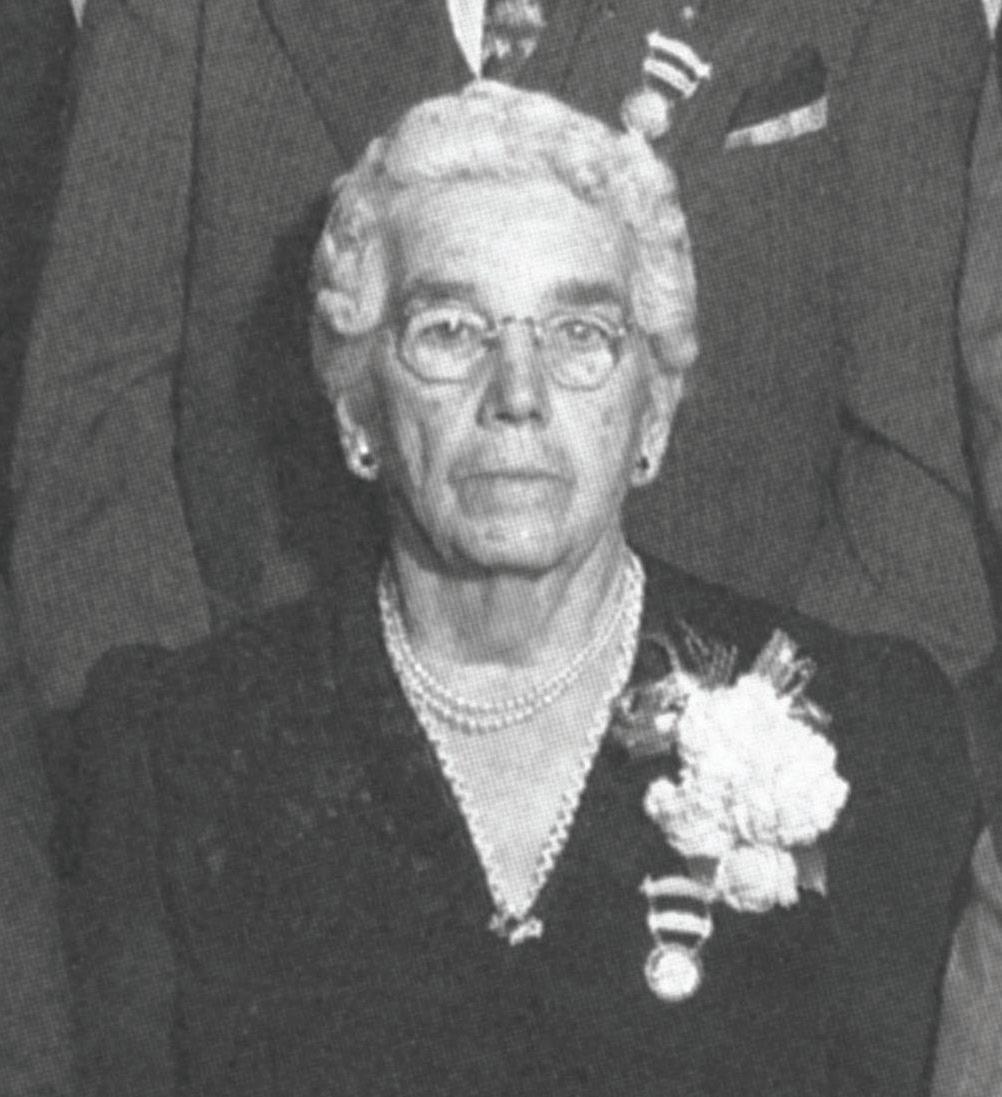
Mary K. Campbell
Mary K. Campbell was for six decades the most well-known member of Wheatfield Arbor in Mason, Michigan. She was its Chief Gleaner for nearly 30 years, helped lead the Ingham County Association, and served as the Society’s Supreme Chaplain from 1947 to 1951. She also was recognized for instructing many of the ritual teams that were featured at Gleaner events.
“Mrs. Campbell was a good leader, and as with all good leaders there were toes treaded on, but mostly after reasoning it out one could see reasons for her commands,” Alice Brown, a longtime Wheatfield Arbor member recalled in a 1984 letter.
Mary Campbell was born Nov. 2, 1876, in Belding, Michigan, to Henry and Cassie Saxton Hinkley. Her family moved to Mason when Mary was 6. She married Alva B. Campbell of Wheatfi eld Township in 1893 — one year before the Society was founded — and became a member in 1916. The couple celebrated their 50th anniversary at the arbor hall they helped build.
Mary Campbell died Nov. 9, 1968, at age 92. She was survived by three daughters, one son, six grandchildren, 13 great-grandchildren and seven great-great-grandchildren. indicate that many people are willing joiners but unwilling helpers.
“In spite of these adverse factors, they are not valid reasons for acceptance of the existing situation. Rather they are the reasons why various changes in our constitution are proposed for adoption at this meeting to permit the beginning of a fund for the promotion and improvement in our fraternal program, and at the same time improve the e ciency of our life insurance service.”
The president’s statement signaled the beginning of an eff ort to re-emphasize fraternalism. As he stated at another time, interest in fraternalism never died among Gleaner membership but it had certainly waned. Television was added to the many alternate forms of entertainment available to people, and by 1957 it overshadowed all others. He also reported:
“It has become practically impossible to secure help in the promotion of fraternal activity on a reasonable cost basis. A budget adequate to secure paid workers would, under present standards, be out of proportion and also subject to criticism by state insurance departments.”
The president appointed a commission to “determine and recommend a program of revitalizing arbors and their activities.” Wayne Hudson, a member of the Supreme Council from Michigan, was named chairman of the committee. He was succeeded a short time later by Joseph G. Kulick of Indiana, also a member of the Supreme Council.
Under the leadership of chairmen Hudson and Kulick, the Fraternal Committee began to make progress. Their eff orts were slowed by lacking money and paid staff , but progress was made. One of the fi rst tasks undertaken was the rewriting of the rituals.
The rituals as written by Grant Slocum from 1888 to 1894 had undergone several revisions. Minor changes were made in 1915 and much more extensive ones in 1926 and 1927. A new “short form” was adopted in 1949. In April of 1958, President Ransford, Roy Rathman and A.P. Decker were appointed to make further revisions. The rituals refl ected the cultural and religious values of the founders

Gleaner arbors provided assistance after tornadoes struck Ohio and Michigan on June 8, 1953. These Forum photos show damage in Wood County, Ohio, where two members were killed. Gleaner President R. G. Ransford, right, helped present a Bloodmobile truck to the American Red Cross on behalf of the National Fraternal Congress in 1954.
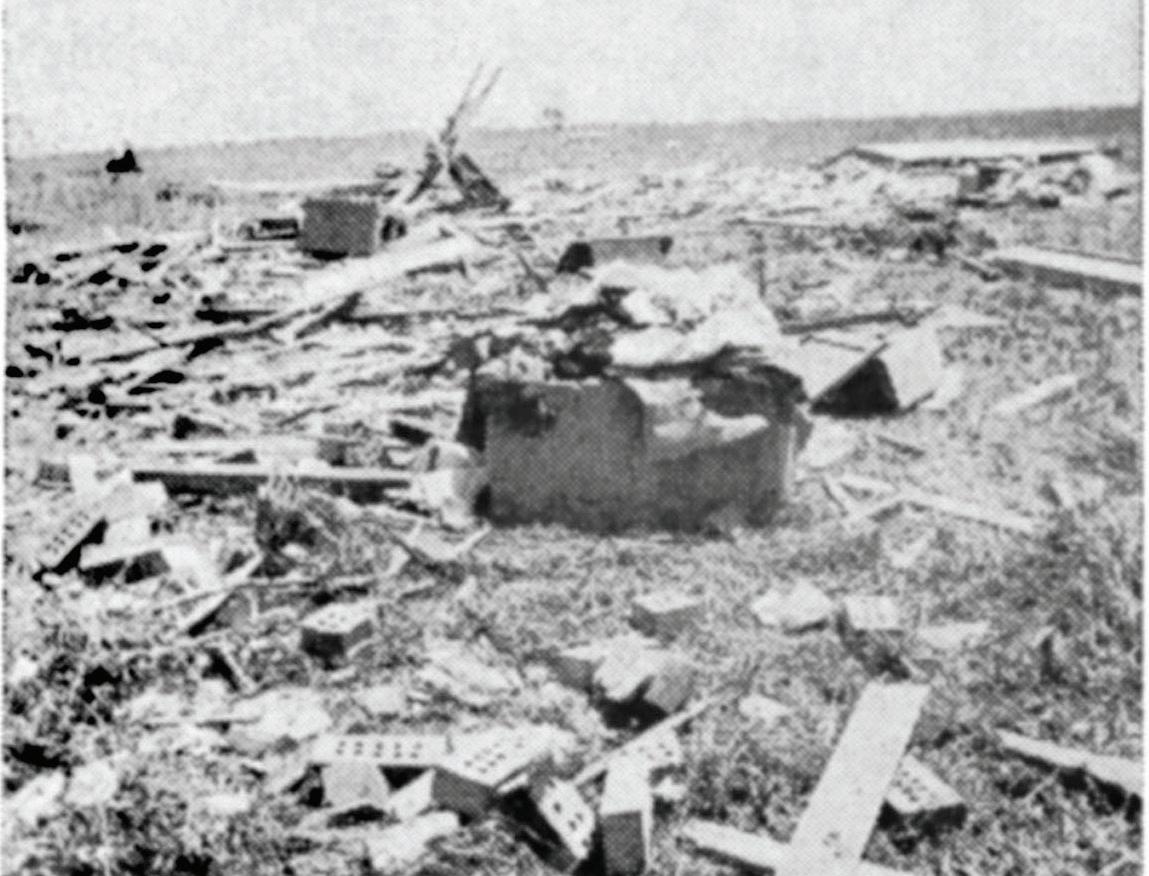
but were out of touch with life in the postwar years. They included church hymns and other religious exercises readily accepted in earlier days, but not by a religiously varied membership. They were both occasionally the subject of criticism by both members and non-members. A few clergymen refused to participate in Gleaner funeral services because of the secret nature of the Society. Some churches forbade their members to join such organizations under threat of excommunication.
As the Society sought to expand membership and renew the fraternalism on which it was based, a nondenominational stand toward religion had to be taken. In July 1953, the Union of French-Canadian Catholics, a small fraternal society based in Michigan, was forced to seek a merger with another fraternal society. Although fi nancially sound, the UFCC was not growing and could not maintain a full insurance program under Michigan laws. In 1953 the UFCC had insurance in force amounting to $565,000 and $319,000 in assets. A merger was approved by Gleaner voters in November 1953 and became fi nal in the fall of 1954. As a result, revision of the rituals became even more necessary. President Ransford made the issue clear when he stated: “The purpose [of the revision] is to eliminate reference to secret work and other matters which might prove objectionable to certain religious denominations.”
The project was completed in April 1961.
Under the guidance of chairmen Hudson and Kulick, several fraternal activities were started. Members responded when June 8, 1953, tornados struck Michigan’s Flint region as well as northwestern Ohio, killing two Ohio members and devastating a large section of Wood County. Gleaner arbors promptly provided relief for stricken members and their families. The National Fraternal Congress Bloodmobile Project was adopted in 1951 and proved to be a success. In 1958, as interest in Junior Gleaner programs waned, the Society began to assist 4-H, which had originated on Ohio farms. One project, sponsored by Leonard Davis and the Portage Central Arbor, helped a group of youngsters buy and fatten farm animals for sale.
In 1964, the Society’s Board of Directors announced the funding of the Gleaner Orphan Fraternal Benefi t, a program to help support and educate the children of deceased members. Children who lost both parents
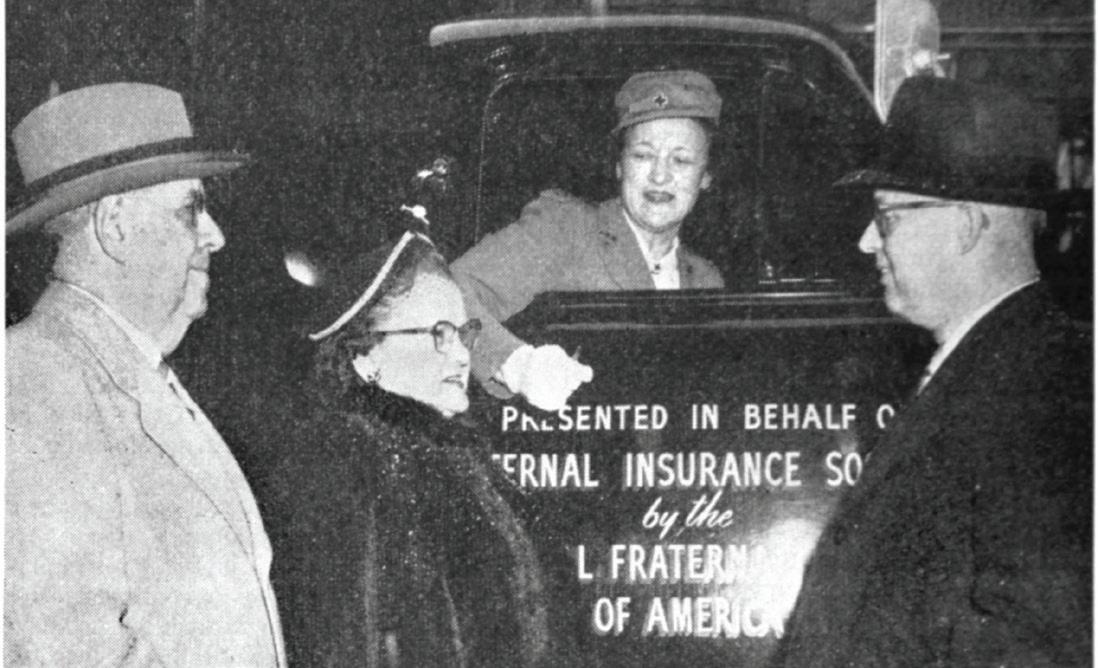
were guaranteed a monthly income. In addition, a total of $6,000 would be paid toward the college costs of qualifi ed applicants. The program was the brainchild of Ransford and its success was a source of pride for him and many others.
Although the eff ort to expand fraternal activities was successful, it became obvious that volunteers could not do it all. In January 1972, Bill B. Warner was appointed to the position of fraternal supervisor, a full-time position. The appointment was important since it committed the Society to a strong fraternal program. Warner had been the associate manager of the Gleaner agency in Bowling Green, Ohio, and was deeply involved in fraternal activities. He replaced the retiring fraternal vice president, Joseph G. Kulick.
As the Gleaner Society grew, President Ransford became a well-known and infl uential fi gure, especially among the more than 100 fraternal societies in the United States. In 1949 he was elected president of the Michigan Fraternal Congress and, in 1959, president of the National Fraternal Congress. He also served as president of the Detroit Mortgage Bankers Association and as a director of First Federal of Michigan, a Detroit bank. He was active in the Detroit Chamber of Commerce and served on the insurance committee for the U.S. Chamber of Commerce.
In 1978 the Gleaner movement was 84 years old and in much better health than it had been a generation earlier. Assets were nearly $39 million, and insurance had increased to more than $170 million. Growth had occurred in spite of recession and infl ation, and promised to continue. Membership was smaller, and still going down, but those remaining represented a hard core of support for the Society. Fraternalism showed signs of revival.
At age 69, and after 32 years as president, George Ransford began to think about retirement. The Board of Directors started the search for a successor, and in July of 1978 employed Frank Dick as senior vice president and secretary. He was clearly in line to become the next president. Ransford formally announced his retirement in April of 1979, and the Board of Directors announced Dick’s appointment the same day.
After retiring from the presidency, Ransford continued to serve the Society as general counsel until his death on June 3, 1985.
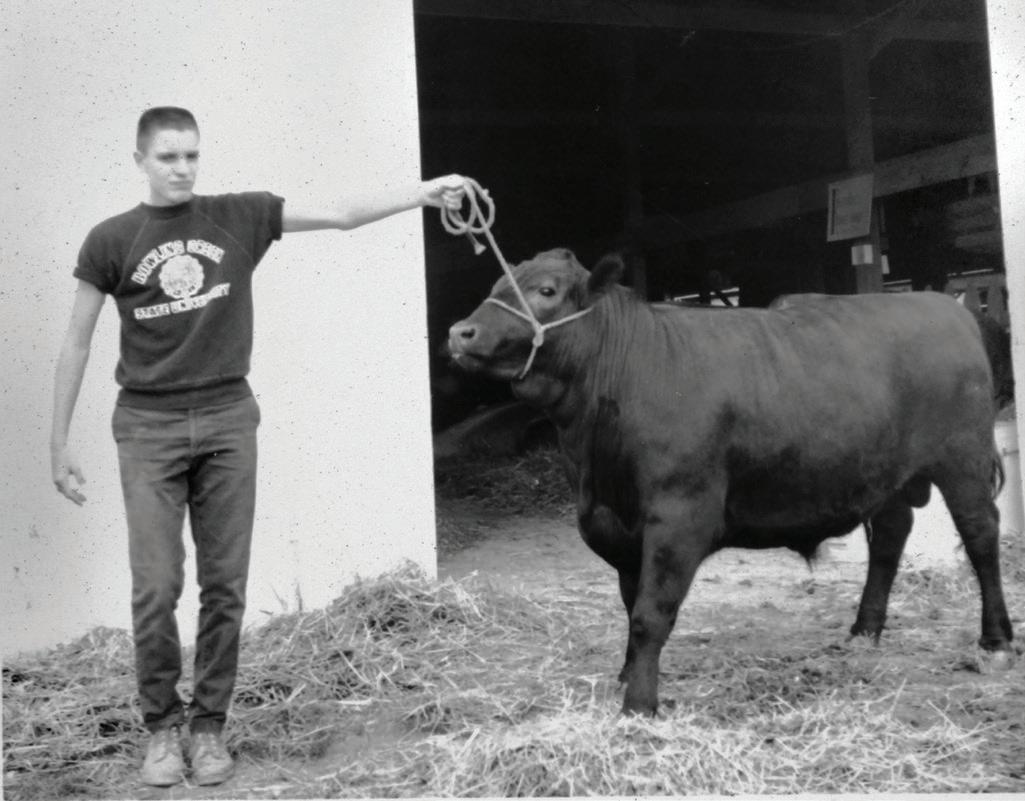
As interest in the Junior Gleaner program waned, the Society in 1958 began assisting 4-H clubs. Bowling Green, Ohio, teen Dick Lemmerbrock was pictured in 1964 at the Wood County Fair. Vice President Frank Dick and wife Shirley in 1978.
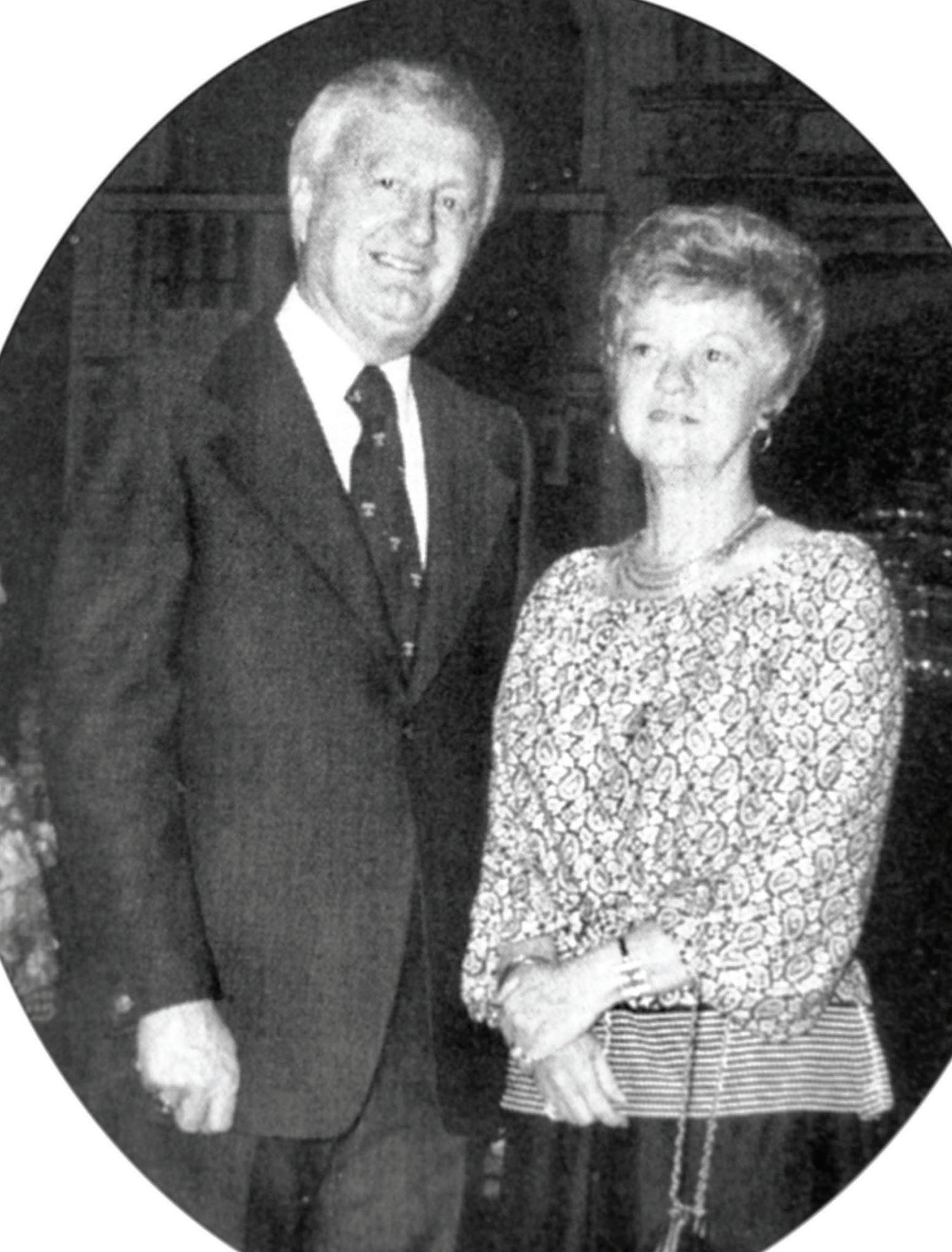
87
88










